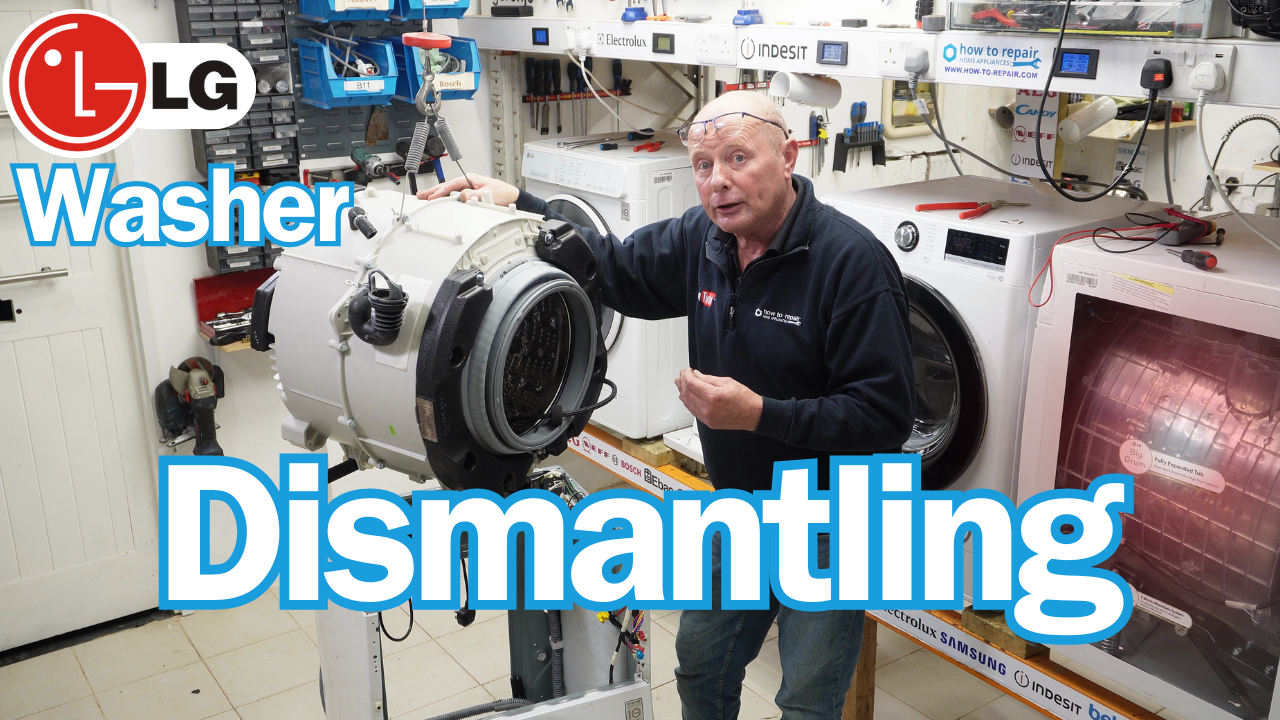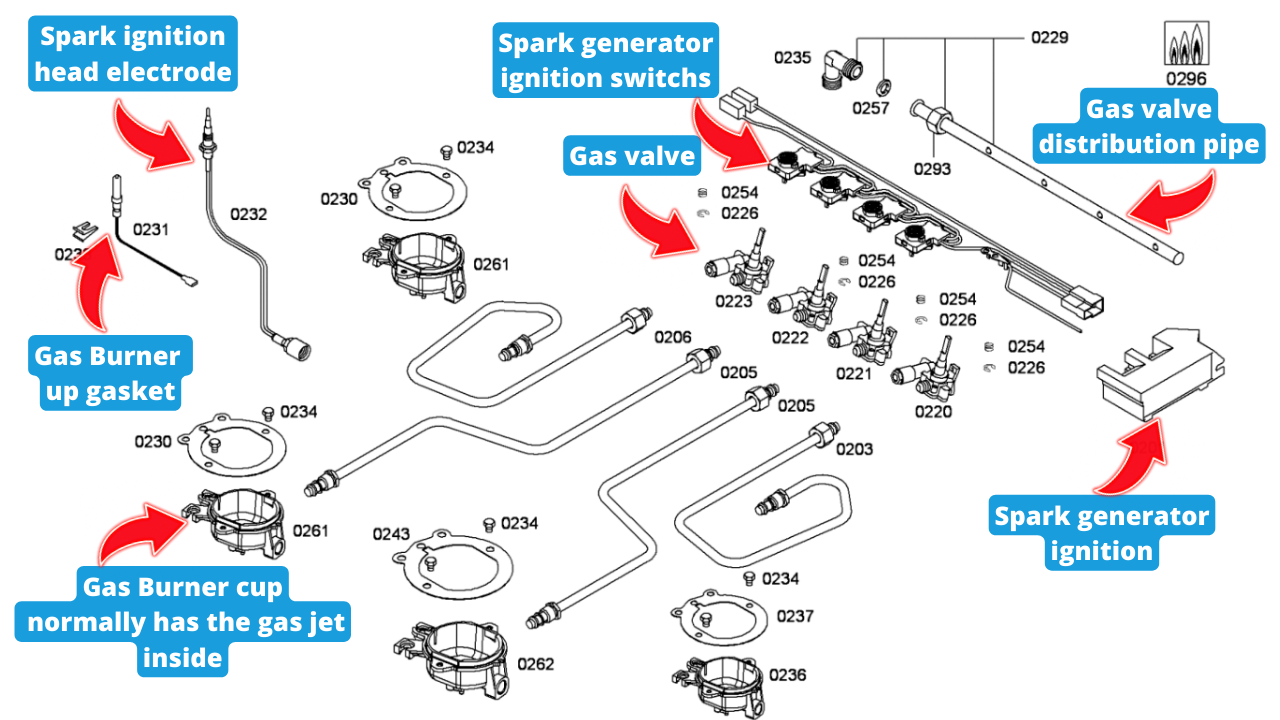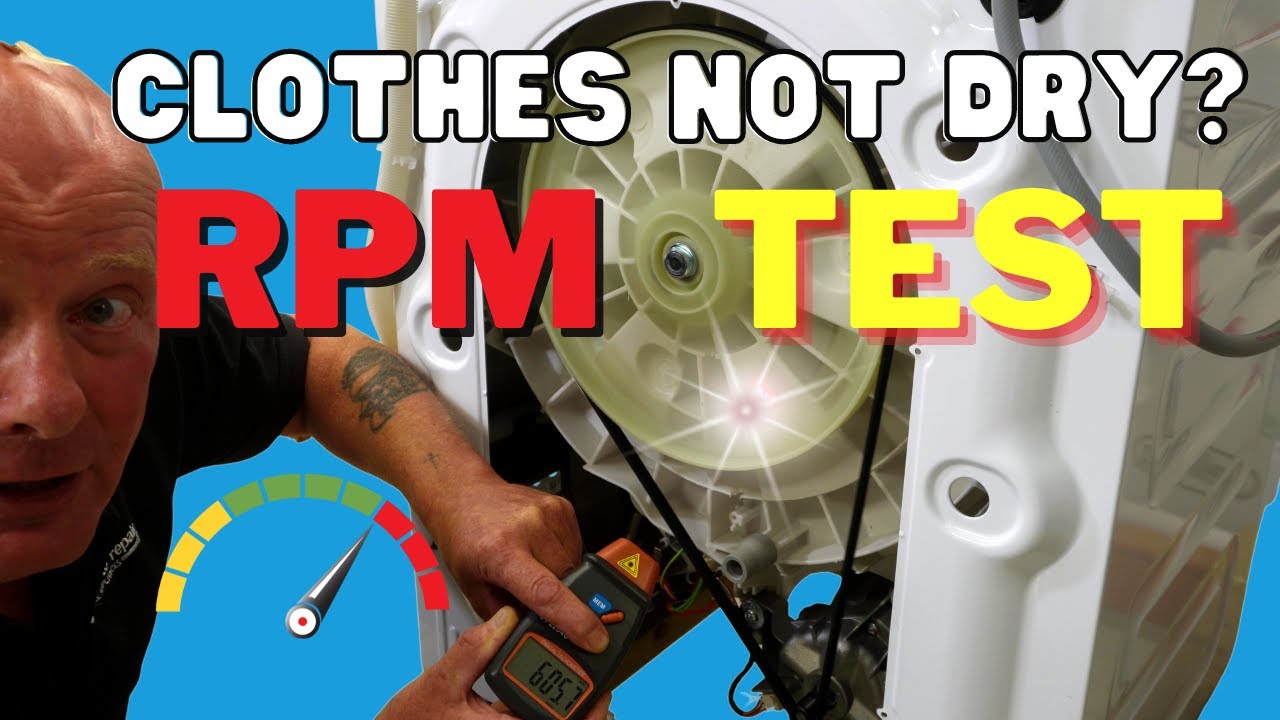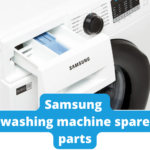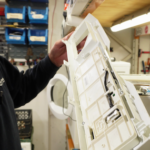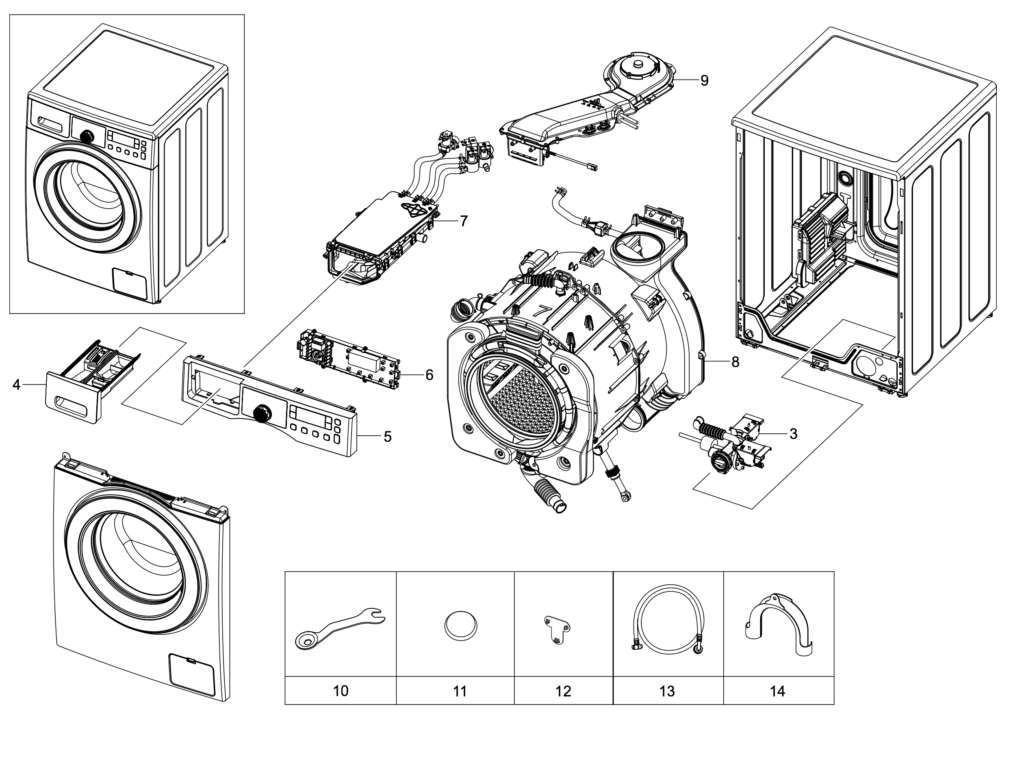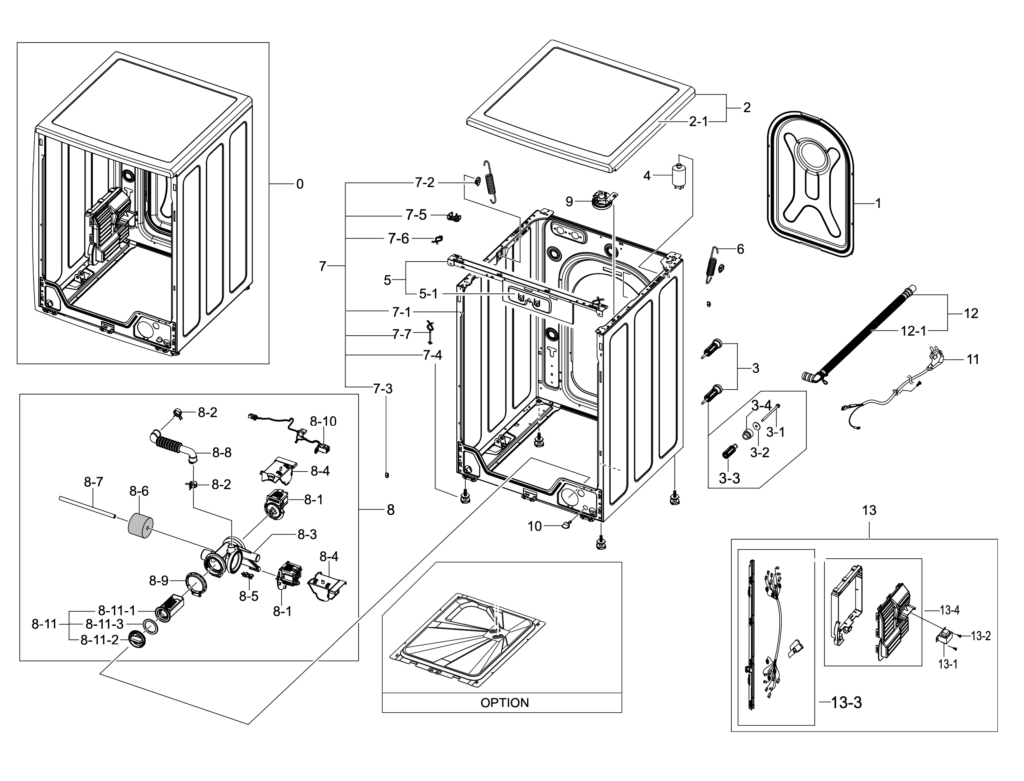Dismantling Samsung washing machine WD0804W8E1/XEU fault finding, and how components work
Samsung EcoBubble Washing Machine Repair Guide: Tackling Common Faults and Error Codes
Introduction In this comprehensive repair guide, we delve into the inner workings of Samsung's EcoBubble washing machine. Whether you're a DIY enthusiast or just looking to troubleshoot your appliance, this guide is your go-to resource. We'll take you through the repair process step by step, covering common faults and error codes that may arise. By the end, you'll have the knowledge and confidence to keep your washing machine running smoothly. At the bottom of the page, you will also find a comprehensive list of error codes for these machines with detailed descriptions of the faults that may be arising.
Please remember whenever looking for spare parts for your machine whether new or used, please use the full model number of the identification plate.
The Repair Process Our video tutorial offers an in-depth look at repairing a Samsung EcoBubble washing machine. Here's a brief outline of what to expect: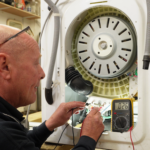
-
Introduction and Machine Overview: We kick things off with a brief introduction to the EcoBubble and highlight the most common issues you might encounter. We'll zoom in on the aluminum spider, a component notorious for causing problems and failing after a few years.
-
Testing the Heating System: To ensure your machine washes effectively, we'll show you how to test the heating element and NTC sensor, essential components for maintaining the right water temperature.
-
Motor Inspection: We'll dive into motor-related issues, including erratic movements, strange noises, and those cryptic error codes (3C, 3C1, 3C2, 3C3) that signal motor trouble.
-
Pump and Drainage System: A malfunctioning drainage system can wreak havoc. Learn how to inspect and clean the pump, sump hose, drainage pipes, and filter to prevent blockages and error codes (D5, 5E, E2) related to drainage. (unable to empty in the allocated period of time)
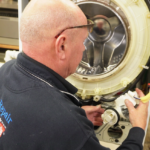
-
Pressure Switch and Water Valve: Discover the importance of the pressure switch in measuring water levels and how to troubleshoot error codes related to water issues and foam.
-
Fan and Condenser Unit: To ensure your laundry dries efficiently, we'll guide you through maintaining the fan and condenser unit. Neglecting these components can result in poor performance and damp clothes.
-
Spider and Drum Removal: For those brave enough to tackle advanced repairs, we'll show you how to remove the drum, spider assembly, and bearings – a fix for spider assembly failure.
-
Spare Parts and Future Use: We'll also discuss the availability of spare parts and provide insights into prolonging the life of your washing machine.
Common Faults and Error Codes Throughout the guide, we'll address various issues that can plague your Samsung EcoBubble washing machine. These include:
-
Spider Assembly Failure: We'll detail why the aluminum spider can become problematic and how it can lead to drum separation.
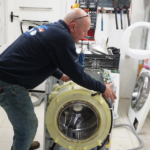
-
Motor Problems: Understand motor-related issues like jerky movements, unusual noises, and the notorious error codes (3C, 3C1, 3C2, 3C3).
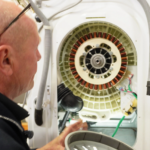
-
Water Drainage Issues: Learn how blocked filters, hoses, or waste pipes can trigger error codes (D5, 5E, E2) associated with drainage problems.
-
Pressure Switch and Water Valve: We'll emphasize how issues with the pressure switch or water valve can result in error codes related to water levels and foam.
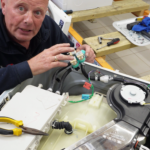
-
Fan and Condenser Maintenance: Discover the importance of maintaining the fan and condenser unit to ensure efficient drying and prevent issues like poor performance and damp clothes.
Tools and Equipment Throughout the repair process, you'll need a few tools and equipment:
-
Multimeter: This device is indispensable for measuring resistance and diagnosing electrical components like the heating element and NTC sensor.
-
Screwdrivers: You'll require these for removing screws that hold various components in place.
- Socket set and spanners: I suggest quarter drive sockets, and spanners up to 19 mm.
-
Plastic Clips and Cable Ties: Use these to secure and organize wiring during disassembly and reassembly.
-
Rubber Hammer: This handy tool is for gentle tapping to aid in the disassembly process.
Conclusion This comprehensive guide equips you with the knowledge and skills to diagnose and address common faults and error codes in your Samsung EcoBubble washing machine. Following our step-by-step instructions and using the recommended tools, you can extend the life of your appliance, save money on repairs, and reduce electronic waste. Make sure to check out our video tutorial for a visual walkthrough of the repair process.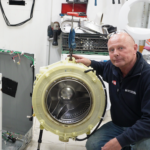
Disclaimer: Always exercise caution and follow safety protocols when working with electrical appliances. If you are unsure about any aspect of the repair process, consider seeking professional assistance.
Everything you need to know about Samsung washing machines, dismantling error codes, fault finding
list of all error codes
| Error Code | Cause | Solution-description |
|---|---|---|
| 1E, E7 | Water Level Sensor Issue | Please check the pressure hose system for any blockages, splits, or deterioration. If no damage is found, and the connection is ok, we recommend replacing the pressure sensor. |
| 3E, 3E1, 3E2, 3E3, 3E4, EA, EB | Motor Defect | Could be an open/short circuit (please check wind resistance), a PCB fault, or a loose connector. |
| 3E1 | Motor Overload | Ensure there isn’t too much laundry in the appliance, the hall sensor terminal isn’t connected, or a possible PCB fault. |
| 3E2 | Motor Driving Error | The motor driving error from the PBA is weak, unstable relay operation. We recommend replacing the Motor PCB. |
| 3E3 | Quiet-Drive Motor Error | Faulty motor hall sensor, faulty PCB connection, or the Quiet Drive motor cover is out of place. |
| 3E4 | Quiet-Drive Motor Defect | The PCB Housing terminal is not connected, there’s a PCB fault, or the Quiet-Motor drive is faulty. |
| 4E, E1 | Water Supply Error (only occurs after 10 mins when the pressure sensor is not detecting the unit filling with water) | Check the water supply is turned on and has adequate water pressure (Samsung recommends a minimum of 0.5bar and a maximum of 8bar), check for any kinks in the hoses, check inlet filters inside the end of Water Valve, check water valve coil resistance, should be 4~5kΩ, check the hose from the drum to the sensor. If this is split or cracked it MUST be replaced. |
| 4E1, 4ED | Water Temperature Issue | Check to ensure the water hose is connected to a cold supply. It must NOT be connected to a hot supply. |
| 4E2 | Water Temperature Error | The water is too hot for the selected wash. |
| 5E, E2 | Water Drain Error (only occurs after 10 mins when water is not draining from the appliance) | Check the drain pump filter for any blockages (e.g., coins, hair clips, lint, etc.), and check the drain hose and connection for any blockages or kinks. |
| 6E | Water Heater Not Functioning | Check the heater resistance which should be around ~27Ω. Use ohms law calculator to work out wattage. |
| 8E | Over Current Error | Switch the appliance off at the mains and wait 30 seconds. Switch the appliance on and try again, if the appliance has an inverter motor check windings are not open circuit - causes juddering. |
| 8E1 | MEMS Sensor Error | Check the connections to the MEMS sensor which is mounted on top of the tub. If they’re all secure then replace the sensor. |
| 9E1, 9E2, PH1, Plo | Power Error | Check the supply voltage, check for loose power connectors or any with contact defects, check for a defective noise filter and fuse. |
| AE, 13E | Signal Communication Error (between the Main PCB and Sub PCB’s) | Check all the connectors on the Main PCB and Sub PCB’s. |
| bE | Motor TRIAC Short Error | Switch off the power and then reconnect and try again. If the error persists then replace the PCB. |
| bE1, 12E | Power Button Fault | Power button held in for more than 13 seconds. |
| bE2, 14E | Control Button Fault | Any button (other than the power button) held in for more than 30 seconds. |
| bE3, 18E | Switch Error | There is a relay fault. |
| CE, E8 | Cooling Error (temperature of water has not dropped below 55°C in 30 minutes after the washer cooling operation) | Check if the water supply is connected to hot and if so change to cold-only feed, check that the hot/cold water supply is not switched over, if the first two are OK then check the heater temperature sensor. |
| dE, Ed | Door Open Error (door not closed correctly/properly) | Door Open Error (door not closed correctly/properly). |
| dE1 | Door Lock Switch Error | Check that the door is closed, check the switch for any damage and if so please replace it. |
| dE2 | On/Off Switch Error | Excessive heat build-up in the coil due to the button being operated continuously. |
| FE | Fan Error (Dryer or Air Refresh fan fault) | Check start condenser/capacitor and fan motor connections, check to see if the fan is jammed, if no other fault then replace the start condenser/capacitor. |
| H1 | Incorrect Water Temperature/Water Temperature rises quickly | Check the temperature sensor, check the pressure switch and hose. |
| HE | Abnormal water temperature | The temperature sensor has detected a temperature over 100°C. |
| HE1, E5 | Water Heater Error (this occurs if the water temperature has not reached 50°C in 20 minutes or does not rise more than 2°C) | Check the heater resistance which should be ~27Ω. |
| HE2 | Dryer Heater Error (occurs if the dryer heater circuit is open circuit) | Check heater TCOs. One is resettable. If it needs to be reset; check the fan for correct operation, check condenser water valve operation, check condenser for blockages. |
| HE3 | Steam Function Fault | Check steam function and TCOs. |
| HOT | Appliance Too Hot (occurs if dryer is turned off early) | This is not a fault - the appliance fan will continue to run until the appliance is cool enough for the washing to be removed. The door will unlock when it is safe. |
| LE, LE1, E9, 11E | Water Leak (low water level detected during cycle) | Check that the level of the drain hose is not lower than the base of the Samsung washing machine. |
| OE, E3 | Overflow Error (too much water/foam has entered into the appliance) | Too much washing powder/liquid may have been added. Turn the power off to the appliance, wait 30 seconds, and then turn on again. The drain pump should kick into action to drain the appliance. Also, check the pressure system for any debris/foam. |
| OF | Overflow Abnormal (water has reached the overflow level) | Check for any water valves which have stuck in the open position, check for debris/foam in the pressure system. |
| Sud | Excess Foam Detected | This is normal operation. The appliance will normally cure this condition on its own, however, if it doesn’t then run either an “Eco drum clean” or a 90°C cotton cycle with no detergent and no washing inside. If the problem persists then please check the pressure system and sump for any debris. |
| t1, t2, tSt | Appliance In Test Mode | Switch the appliance off at the mains and wait 30 seconds. Then, switch it back on and try again. |
| tE, EC | Temperature Sensor Abnormal Issue | Switch off the power and reconnect and try again. Check all the temperature sensors for relative continuity. |
| tE1 | Water Heater Temp Sensor Defective | Check the connections to the sensor and PCB, check resistance which should be ~12.8kΩ. |
| tE2 | Fan Housing Duct Sensor Defective | Check the connections to the sensor and PCB, check resistance which should be ~12.8kΩ. |
| tE3 | Condenser Duct Sensor Defective | Check the connections to the sensor and PCB, check resistance which should be ~12.8kΩ. |
| UC | Excessive Fluctuation In The Supply Voltage (voltage has fluctuated outside 176-286vAC) | Check that the supply voltage is within specifications, reset the power supply to clear the error. If the error cannot be reset then please replace the main PCB. |
| UE, E4 | Unbalanced Error (the washing load in the drum is unbalanced i.e. clothes may have got trapped inside a large towel and resting on one side of the drum) | This could be normal operation where the washing machine is stopping the spin for safety reasons. Please distribute washing more evenly. Check the weights and balancers for condition, check the shock absorbers for condition, check the springs for condition. |
| Error Code | Cause | Solution-description |
|---|---|---|
| Error Code | Cause | Solution-description |
| 1E, E7 | Water Level Sensor Issue | Please check the pressure hose system for any blockages, splits, or deterioration. If no damage is found, and the connection is ok, we recommend replacing the pressure sensor. |
| 3E, 3E1, 3E2, 3E3, 3E4, EA, EB | Motor Defect | Could be an open/short circuit (please check wind resistance), a PCB fault, or a loose connector. |
| 30 | Motor Overload | Ensure there isn’t too much laundry in the appliance, the hall sensor terminal isn’t connected, or a possible PCB fault. |
| 300 | Motor Driving Error | The motor driving error from the PBA is weak, unstable relay operation. We recommend replacing the Motor PCB. |
| 3000 | Quiet-Drive Motor Error | Faulty motor hall sensor, faulty PCB connection, or the Quiet Drive motor cover is out of place. |
| 30000 | Quiet-Drive Motor Defect | The PCB Housing terminal is not connected, there’s a PCB fault, or the Quiet-Motor drive is faulty. |
| 4E, E1 | Water Supply Error (only occurs after 10 mins when the pressure sensor is not detecting the unit filling with water) | Check the water supply is turned on and has adequate water pressure (Samsung recommends a minimum of 0.5bar and a maximum of 8bar), check for any kinks in the hoses, check inlet filters inside the end of Water Valve, check water valve coil resistance, should be 4~5kΩ, check the hose from the drum to the sensor. If this is split or cracked it MUST be replaced. |
| 4E1, 4ED | Water Temperature Issue | Check to ensure the water hose is connected to a cold supply. It must NOT be connected to a hot supply. |
| 400 | Water Temperature Error | The water is too hot for the selected wash. |
| 5E, E2 | Water Drain Error (only occurs after 10 mins when water is not draining from the appliance) | Check the drain pump filter for any blockages (e.g., coins, hair clips, lint, etc.), and check the drain hose and connection for any blockages or kinks. |
| 6E | Water Heater Not Functioning | Check the heater resistance which should be around ~27Ω. Use ohms law calculator to work out wattage. |
| 8E | Over Current Error | Switch the appliance off at the mains and wait 30 seconds. Switch the appliance on and try again, if the appliance has an inverter motor check windings are not open circuit - causes juddering. |
| 80 | MEMS Sensor Error | Check the connections to the MEMS sensor which is mounted on top of the tub. If they’re all secure then replace the sensor. |
| 9E1, 9E2, PH1, Plo | Power Error | Check the supply voltage, check for loose power connectors or any with contact defects, check for a defective noise filter and fuse. |
| AE, 13E | Signal Communication Error (between the Main PCB and Sub PCB’s) | Check all the connectors on the Main PCB and Sub PCB’s. |
| bE | Motor TRIAC Short Error | Switch off the power and then reconnect and try again. If the error persists then replace the PCB. |
| bE1, 12E | Power Button Fault | Power button held in for more than 13 seconds. |
| bE2, 14E | Control Button Fault | Any button (other than the power button) held in for more than 30 seconds. |
| bE3, 18E | Switch Error | There is a relay fault. |
| CE, E8 | Cooling Error (temperature of water has not dropped below 55°C in 30 minutes after the washer cooling operation) | Check if the water supply is connected to hot and if so change to cold-only feed, check that the hot/cold water supply is not switched over, if the first two are OK then check the heater temperature sensor. |
| dE, Ed | Door Open Error (door not closed correctly/properly) | Door Open Error (door not closed correctly/properly). |
| dE1 | Door Lock Switch Error | Check that the door is closed, check the switch for any damage and if so please replace it. |
| dE2 | On/Off Switch Error | Excessive heat build-up in the coil due to the button being operated continuously. |
| FE | Fan Error (Dryer or Air Refresh fan fault) | Check start condenser/capacitor and fan motor connections, check to see if the fan is jammed, if no other fault then replace the start condenser/capacitor. |
| H1 | Incorrect Water Temperature/Water Temperature rises quickly | Check the temperature sensor, check the pressure switch and hose. |
| HE | Abnormal water temperature | The temperature sensor has detected a temperature over 100°C. |
| HE1, E5 | Water Heater Error (this occurs if the water temperature has not reached 50°C in 20 minutes or does not rise more than 2°C) | Check the heater resistance which should be ~27Ω. |
| HE2 | Dryer Heater Error (occurs if the dryer heater circuit is open circuit) | Check heater TCOs. One is resettable. If it needs to be reset; check the fan for correct operation, check condenser water valve operation, check condenser for blockages. |
| HE3 | Steam Function Fault | Check steam function and TCOs. |
| HOT | Appliance Too Hot (occurs if dryer is turned off early) | This is not a fault - the appliance fan will continue to run until the appliance is cool enough for the washing to be removed. The door will unlock when it is safe. |
| LE, LE1, E9, 11E | Water Leak (low water level detected during cycle) | Check that the level of the drain hose is not lower than the base of the Samsung washing machine. |
| OE, E3 | Overflow Error (too much water/foam has entered into the appliance) | Too much washing powder/liquid may have been added. Turn the power off to the appliance, wait 30 seconds, and then turn on again. The drain pump should kick into action to drain the appliance. Also, check the pressure system for any debris/foam. |
| OF | Overflow Abnormal (water has reached the overflow level) | Check for any water valves which have stuck in the open position, check for debris/foam in the pressure system. |
| Sud | Excess Foam Detected | This is normal operation. The appliance will normally cure this condition on its own, however, if it doesn’t then run either an “Eco drum clean” or a 90°C cotton cycle with no detergent and no washing inside. If the problem persists then please check the pressure system and sump for any debris. |
| t1, t2, tSt | Appliance In Test Mode | Switch the appliance off at the mains and wait 30 seconds. Then, switch it back on and try again. |
| tE, EC | Temperature Sensor Abnormal Issue | Switch off the power and reconnect and try again. Check all the temperature sensors for relative continuity. |
| tE1 | Water Heater Temp Sensor Defective | Check the connections to the sensor and PCB, check resistance which should be ~12.8kΩ. |
| tE2 | Fan Housing Duct Sensor Defective | Check the connections to the sensor and PCB, check resistance which should be ~12.8kΩ. |
| tE3 | Condenser Duct Sensor Defective | Check the connections to the sensor and PCB, check resistance which should be ~12.8kΩ. |
| UC | Excessive Fluctuation In The Supply Voltage (voltage has fluctuated outside 176-286vAC) | Check that the supply voltage is within specifications, reset the power supply to clear the error. If the error cannot be reset then please replace the main PCB. |
| UE, E4 | Unbalanced Error (the washing load in the drum is unbalanced i.e. clothes may have got trapped inside a large towel and resting on one side of the drum) | This could be normal operation where the washing machine is stopping the spin for safety reasons. Please distribute washing more evenly. Check the weights and balancers for condition, check the shock absorbers for condition, check the springs for condition. |
-
How to replace & fit a Samsung washing machine door seal gasket
-
How to enter test mode or diagnostic mode on Samsung washing machine
-
How to run the calibration mode on Samsung washing machine
-
Samsung Washing Machine DC Error Fault Code
-
Samsung washing machine DE error code Door lock fault
-
Samsung washing machine 5E or 2E error code Fault.Pump fault not emptying
-
Samsung washing machine error code 4E and E1 Fault Not filling in Allocated Time
-
Samsung Washing Machine TE & HE Error Code Heating Fault
-
Samsung Washing Machine 3E Error Code not spinning or turning
-
How to Activate and Deactivate Child lock on Samsung Ecobubble Washing Machine
Understanding Samsung washing machines components and functionality
# Samsung Washing Machine Troubleshooting Guide
## Door Lock Issues
- **Symptoms**: The door lock needs to be locked to start its cycle and keeps kids from opening it during use. If you can choose a program but nothing happens when pressing start, your door lock might be broken. You may even hear the faulty lock clicking.
## Washing Machine Fill System Explained
- The washing machine's fill system starts with a water inlet valve that leads to the soap drawer.
- The water then flows through the fill-to-drum hose into the machine.
- A pressure switch at the front measures the amount of water.
- This switch connects to a large bowl and small pipe.
- As it fills, air is pressurized and sent up to the pressure switch or one on a circuit board telling the machine its current water level.
## Heating System
- The heating system usually includes one or two temperature sensors, which can be mechanical thermostats or modern NTC sensors.
- These NTC sensors send resistance readings to the circuit board, and this changes with temperature.
- A relay on the board activates the heater until it hits the desired temperature.
- **Common Issues**: Faulty heater, sensor, relay on the board, or wiring issue can cause heating problems. A damaged heating element can also trip your house's electricity supply.
## Drainage Process
- The drain system works during the rinse cycle or final spin.
- The drum spins, flinging water out of the clothes and down to the bottom of the machine.
- This water goes through a sump hose that may contain a ball, which prevents your soap powder going into the pump system when filling.
- It then moves to the pump where it gets pressurized for removal from the machine.
## Motor Action
- The motor, usually located at the bottom, has a tachometer attached to inform the circuit board about its speed.
- During wash cycles, it rotates in either direction as directed by a relay or triac.
- On some washing machines, there is more than one circuit board.
- As the washer continues running, it enters a rinse cycle where spin speeds change based on its stage in the cycle.
- The speed then boosts to match what's set on the program for that portion of cleaning.
## Suspension System
- Washing machines have a suspension system, much like cars, with two or three legs to stabilize the drum during wash cycles.
- If these legs wear out or get damaged, the machine may shake and make loud noises.
- It's important to replace worn-out legs to prevent this issue.
- Overloading the machine or not balancing clothes in the drum can also cause it to vibrate and produce unpleasant sounds.
## Drums
- The drum of a Samsung washing machine is usually made from stainless or coated steel to prevent rust.
- It's attached to a three-legged spider at the back, which connects to the drum shaft and runs through seals and bearings.
- The drum shaft connects to the back pulley wheel (which is connected via belt to the motor allowing rotation).
- The outer part is watertight with hose access for filling or emptying.
- To avoid shaking, concrete blocks or plastic-encased weights are bolted onto the sides as counterweights.
- On washer-dryers, a condensing unit at the rear lets water trickle down while in dry mode, converting water vapor into liquid.
- Every few years, it’s wise to check if these parts are still in good shape.
- The electrical system connects to the power source through a plug.
- A suppressor or filter regulates the electricity flow and prevents interference with other household items.
- The washing machine uses two circuit boards: one for programming specific to that model, and another for its display.
- These circuit boards contain elements like relays, triax, resistors, diodes, capacitors, etc., enabling them to control electricity supply to different parts of the machine at various times.
- A water pressure switch measures the amount of water in the machine at any given time.
- The programs are typically embedded into an EPROM system unique to each model.
- Bad wiring or faulty devices can cause a short circuit damaging these boards beyond repair.
Samsung WD0804W8E1/XEU washing machine diagram of all components
If this is not your model, you will need to locate the full model number to identify the specific component needed. This will provide you with a genuine part number. If we do not have it in stock, utilise this information to search other platforms such as Amazon and eBay.
For high-value items like motors and drums, consider adding the search to your favourites; patience may yield results over several weeks as these components emerge on shopping networks. It is also prudent to investigate compatible models for your appliance.
Bear in mind that an equivalent machine might be found on eBay – one could potentially "rob Charlie to make Peter better," so to speak.
Below are the diagrams from this Samsung WD0804W8E1/XEU washing machine use the number on the picture to go to the list at the bottom of the page to identify the correct part for your washing machine.
Parts list for Samsung washing machine WD0804W8E1/XEU
| Drawing Number | Part Number | Description |
|---|---|---|
| 3 | DC97-15696J | ASSY PUMP DRAIN |
| 4 | DC97-16655A | ASSY PANEL DRAWER |
| 5 | DC97-16867A | ASSY PANEL CONTROL |
| 6 | DC92-00532A | ASSY PCB SUB |
| 7 | DC97-16005E | ASSY HOUSING DRAWER |
| 8 | DC90-13641A | ASSY TUB&DRUM |
| 9 | DC93-00033A | ASSY DUCT SCROLL |
| 10 | DC60-00104A | FASTENER-BOLT |
| 11 | DC67-00208B | CAP-FIXER |
| 12 | DC67-00307A | CAP-FIXER |
| 13 | DC97-16921A | ASSY HOSE WATER |
| 14 | DC62-10278A | HOSE-HANGER |
Parts Table
| Drawing Number | New Search Code | Description |
|---|---|---|
| 1 | DC63-00862C | COVER-BACK |
| 2 | DC97-14953A | ASSY COVER TOP |
| 2-1 | DC63-00910A | COVER-TOP |
| 3 | DC97-14794C | ASSY FIXER TUB |
| 3-1 | 6011-001669 | BOLT-HEX |
| 3-2 | DC60-60044B | WASHER-PLAIN |
| 3-3 | DC61-02028B | FIXER-TUB |
| 3-4 | DC73-00035A | FIXER-RUBBER |
| 4 | DC29-00015F | FILTER-EMI |
| 5 | DC97-15557A | ASSY FRAME PLATE(U) |
| 5-1 | DC61-02376A | BRACKET-DUCT SCROLL |
| 6 | DC61-02029B | SPRING ETC-HANGER |
| 7 | DC97-16817T | ASSY PAINT FRAME |
| 7-1 | DC97-16439H | ASSY FRAME |
| 7-2 | DC61-02065A | GUIDE-SPRING |
| 7-3 | DC61-01901A | GUIDE-FRAME FRONT |
| 7-4 | DC97-00920H | ASSY LEG |
| 7-5 | DC61-00133A | CLAMPER HOSE-FIX |
| 7-6 | DC61-40081A | HOLDER-WIRE |
| 7-7 | DC61-00995C | HOLDER-WIRE |
| 8 | DC97-15696J | ASSY PUMP DRAIN |
| 8-1 | DC31-30008D | PUMP-DRAIN |
| 8-2 | DC61-00158A | CLAMPER HOSE |
| 8-3 | DC61-02271B | CASE-PUMP |
| 8-4 | DC63-01410A | COVER-PUMP |
| 8-5 | DC63-00905A | CUSHION-PUMP |
| 8-6 | DC63-10003C | SPONGE-HOSE AIR |
| 8-7 | DC67-00244M | HOSE DRAIN |
| 8-8 | DC67-00461A | HOSE-AIR TUB |
| 8-9 | DC69-01128A | PACKING-PUMP |
| 8-10 | DC93-00016C | ASSY WIRE HARNESS-PUMP |
| 8-11 | DC97-15695C | ASSY FILTER |
| 8-11-1 | DC63-00998A | FILTER-PUMP |
| 8-11-2 | DC64-02783A | HANDLE-FILTER |
| 8-11-3 | DC73-00022A | SEAL-PACKING |

